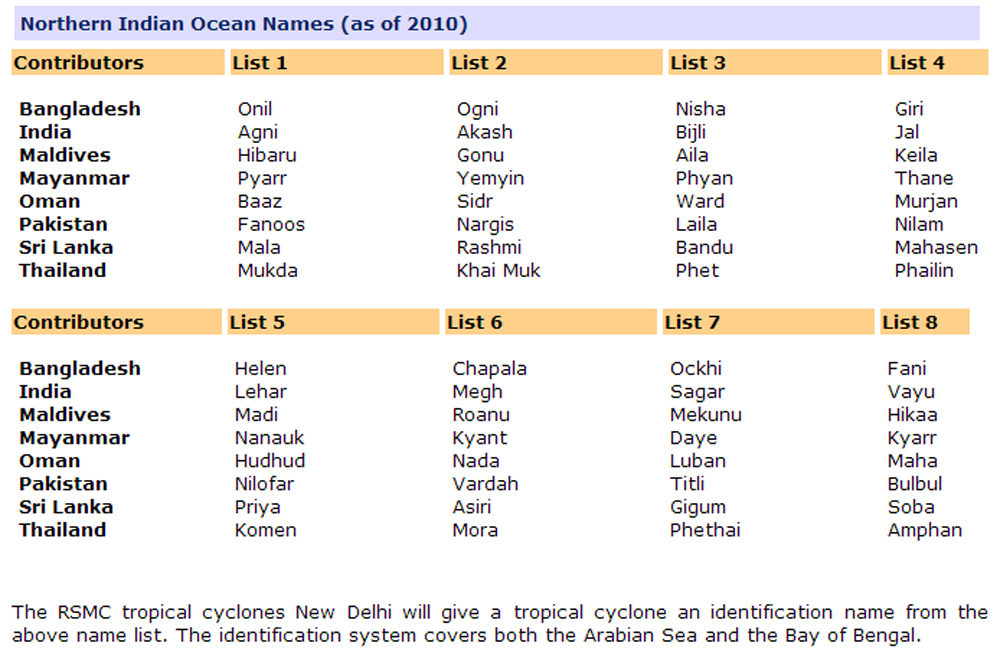Ever wondered about the history behind the names given to the
devastating cyclones which have caused severe destruction to the lives
of thousands of people and incurred heavy losses to the growth of a
particular country?
The process of naming cyclones began
some years ago for the sole purpose of making it easier to identify the
origin of the cyclone instead of remembering the technical terms
associated with the cyclone. It proved to be more accurate than the old
fashioned method of identifying the cyclone, i.e., latitude and
longitude etc, which was more error prone.
The regions are - Atlantic Ocean, Eastern Pacific, Central Pacific, West Pacific, North Indian, South West Indian Ocean, Australian and South Pacific Ocean.
A cyclone, typhoon and hurricane are all
the same but different names specific to the region. Hurricane is a
name used in Eastern Pacific belt while typhoon is used in Northern Pacific Ocean and cyclone is in the South Pacific Ocean and Indian Ocean regions.
How are the cyclones named?
Initially, the cyclones were named after the place they did the most damage (such as the Galveston Hurricane of 1900 and the Labour Day Hurricane of 1935).
This continued till the end of WORLD War 2. Later, the cyclones were named after women such as Alice, Barbara, Carol, Dolly, Edna, Florence, Gilda, Hazel, Irene, Jill, Katherine, Lucy, Mabel, Norma, Orpha etc. However by the beginning of 1980, both men and women's names were used to identify these cyclones.
There is a strict procedure to determine
a list of tropical cyclone names in an ocean basin(s) by the Tropical
Cyclone Regional Body responsible for that basin(s) at its
annual/biennial meeting.
There are five tropical cyclone regional
bodies, i.e. ESCAP/WMO Typhoon Committee, WMO/ESCAP Panel on Tropical
Cyclones, RA I Tropical Cyclone Committee, RA IV Hurricane Committee,
and RA V Tropical Cyclone Committee.
For instance, Hurricane Committee
determines a pre-designated list of hurricane names for six years
separately at its annual session. The pre-designated list of hurricane
names are proposed by its members. Naming procedures in other regions
are almost the same as in the Caribbean. In general, tropical cyclones
are named according to the rules at a regional level.
It is important to note that tropical
cyclones are named neither after any particular person, nor with any
preference in alphabetical sequence. The tropical cyclone names selected
are those that are familiar to the people in each region. Obviously,
the main purpose of naming a tropical cyclone is basically for people
easily to understand and remember the tropical cyclone in a region, thus
to facilitate tropical cyclone disaster risk awareness, preparedness,
management and reduction.
However, giving an official name to the cyclone is a recent phenomenon. Every region forms a committee of nations who are more prone to cyclones or hurricanes and comes up with its own list of names which is then examined by the governing body set up by the nations.
For the Indian ocean region, the host nations constitute of Bangladesh, India, Maldives, Myanmar, Oman, Pakistan, Sri Lanka and Thailand and the governing body is Regional Specialised Meteorological Centre, New Delhi.
Each nation prepares a list of ten names which they think is suitable to be assigned to a cyclone. Out of these, the governing body, i.e, RSMC , selects eight names from each country and accordingly prepares eight lists which consist of the names approved by the governing body.
Following is the list of the Northern Indian ocean cyclone names (As of 2010)

According to the list, the first cyclone which occurred in the Indian Ocean in the year 2004 was named Onil. The second cyclone to hit the Indian Ocean was named Agni which was a name submitted by India. Since then, the cyclones have been named according to the list approved by RSMC with the recent one being Cyclone Helen, a name given by Bangladesh.
Get set to hear about Cyclone Madi next, as this name is the one
Maldives has given and is scheduled to be used for a cyclone in the
Indian Ocean region.
No comments:
Post a Comment